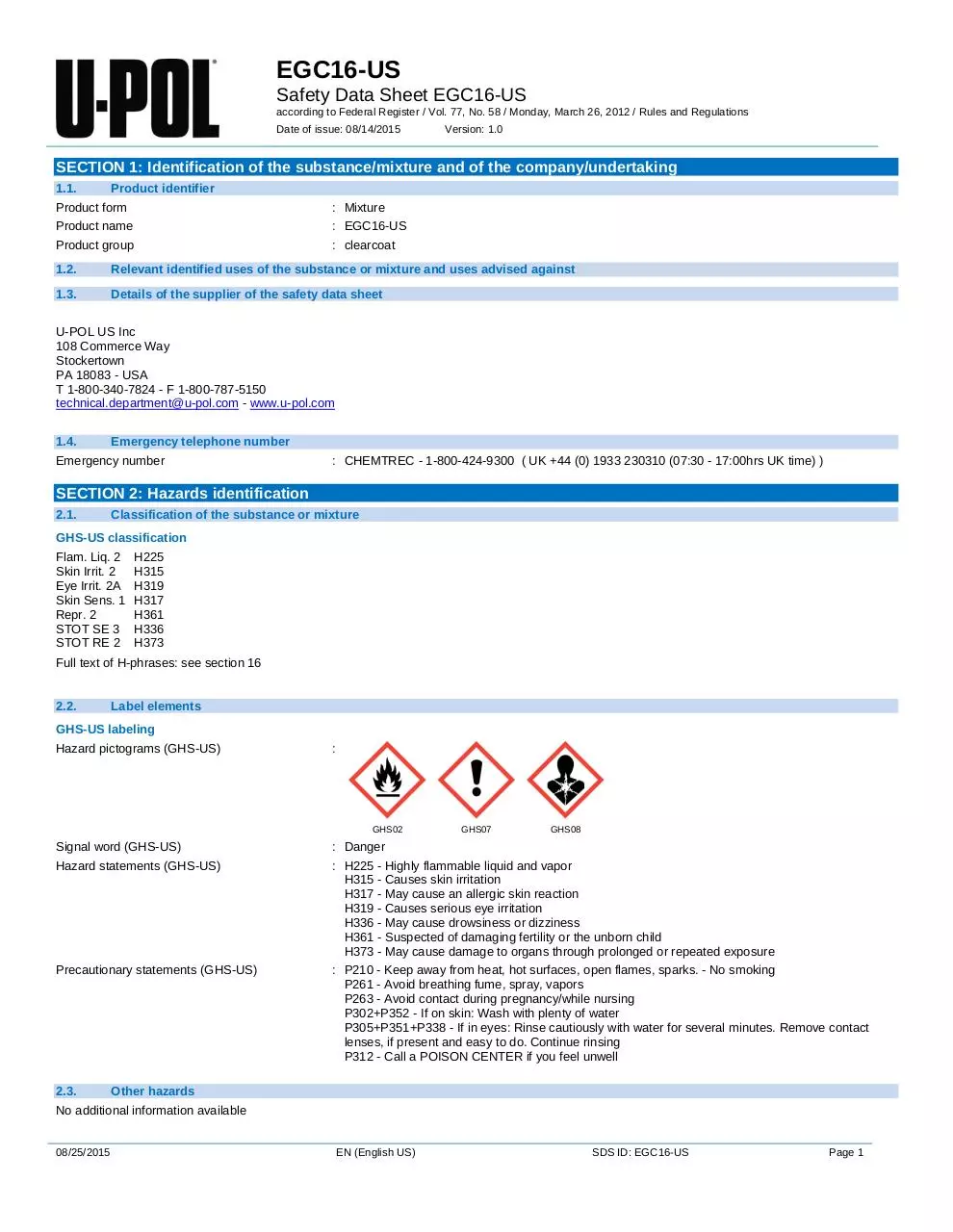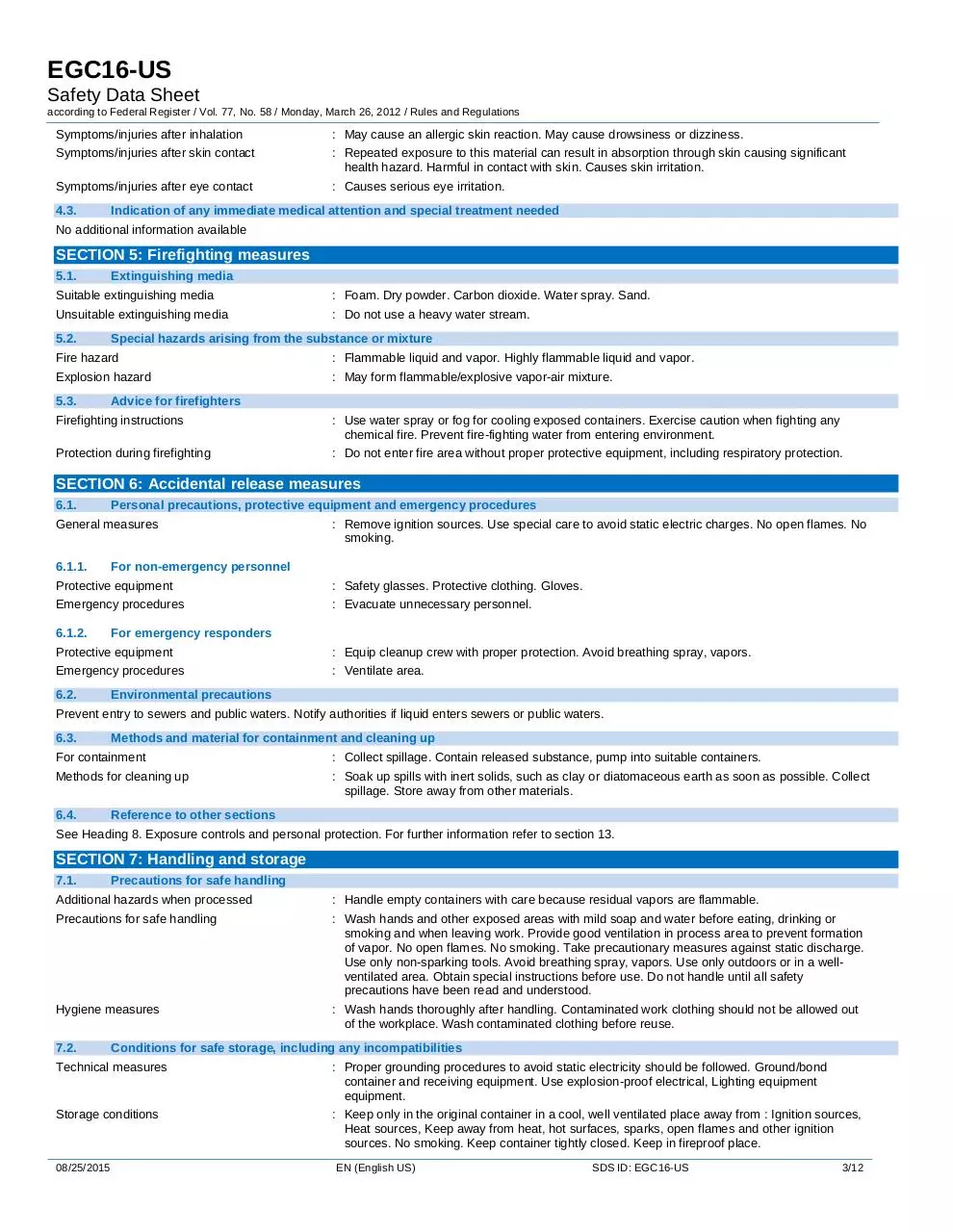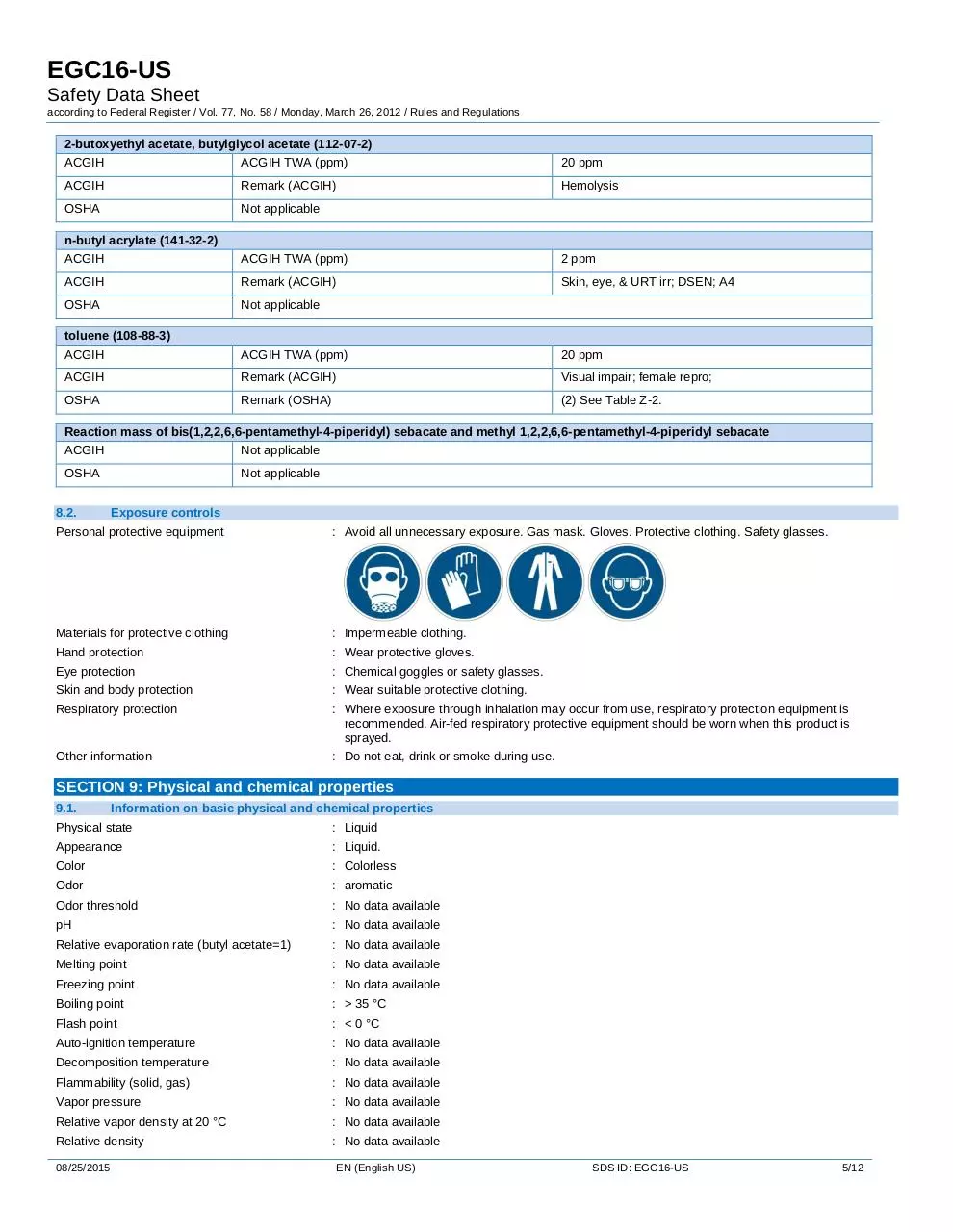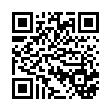EGC16 US SDS EN (PDF)
File information
This PDF 1.5 document has been generated by Microsoft® Word 2010, and has been sent on pdf-archive.com on 21/06/2016 at 20:31, from IP address 73.183.x.x.
The current document download page has been viewed 271 times.
File size: 475.72 KB (12 pages).
Privacy: public file





File preview
EGC16-US
Safety Data Sheet EGC16-US
according to Federal Register / Vol. 77, No. 58 / Monday, March 26, 2012 / Rules and Regulations
Date of issue: 08/14/2015
Version: 1.0
SECTION 1: Identification of the substance/mixture and of the company/undertaking
1.1.
Product identifier
Product form
: Mixture
Product name
: EGC16-US
Product group
: clearcoat
1.2.
Relevant identified uses of the substance or mixture and uses advised against
1.3.
Details of the supplier of the safety data sheet
U-POL US Inc
108 Commerce Way
Stockertown
PA 18083 - USA
T 1-800-340-7824 - F 1-800-787-5150
technical.department@u-pol.com - www.u-pol.com
1.4.
Emergency telephone number
Emergency number
: CHEMTREC - 1-800-424-9300 ( UK +44 (0) 1933 230310 (07:30 - 17:00hrs UK time) )
SECTION 2: Hazards identification
2.1.
Classification of the substance or mixture
GHS-US classification
Flam. Liq. 2
Skin Irrit. 2
Eye Irrit. 2A
Skin Sens. 1
Repr. 2
STOT SE 3
STOT RE 2
H225
H315
H319
H317
H361
H336
H373
Full text of H-phrases: see section 16
2.2.
Label elements
GHS-US labeling
Hazard pictograms (GHS-US)
:
Signal word (GHS-US)
: Danger
Hazard statements (GHS-US)
: H225 - Highly flammable liquid and vapor
H315 - Causes skin irritation
H317 - May cause an allergic skin reaction
H319 - Causes serious eye irritation
H336 - May cause drowsiness or dizziness
H361 - Suspected of damaging fertility or the unborn child
H373 - May cause damage to organs through prolonged or repeated exposure
Precautionary statements (GHS-US)
: P210 - Keep away from heat, hot surfaces, open flames, sparks. - No smoking
P261 - Avoid breathing fume, spray, vapors
P263 - Avoid contact during pregnancy/while nursing
P302+P352 - If on skin: Wash with plenty of water
P305+P351+P338 - If in eyes: Rinse cautiously with water for several minutes. Remove contact
lenses, if present and easy to do. Continue rinsing
P312 - Call a POISON CENTER if you feel unwell
GHS02
2.3.
GHS07
GHS08
Other hazards
No additional information available
08/25/2015
EN (English US)
SDS ID: EGC16-US
Page 1
EGC16-US
Safety Data Sheet
according to Federal Register / Vol. 77, No. 58 / Monday, March 26, 2012 / Rules and Regulations
2.4.
Unknown acute toxicity (GHS-US)
Not applicable
SECTION 3: Composition/information on ingredients
3.1.
Substance
Not applicable
3.2.
Mixture
Name
Product identifier
%
GHS-US classification
xylene
(CAS No) 1330-20-7
5 - 23
Flam. Liq. 3, H226
Acute Tox. 4 (Dermal), H312
Acute Tox. 4 (Inhalation:dust,mist),
H332
Skin Irrit. 2, H315
methyl acetate
(CAS No) 79-20-9
5 - 23
Flam. Liq. 2, H225
Eye Irrit. 2A, H319
STOT SE 3, H336
4-methylpentan-2-one, isobutyl methyl ketone
(CAS No) 108-10-1
5 - 23
Flam. Liq. 2, H225
Acute Tox. 4 (Inhalation), H332
Eye Irrit. 2A, H319
STOT SE 3, H335
Acetone
(CAS No) 67-64-1
5 - 23
Flam. Liq. 2, H225
Eye Irrit. 2A, H319
STOT SE 3, H336
ethylbenzene
(CAS No) 100-41-4
< 23
Flam. Liq. 2, H225
Acute Tox. 4 (Inhalation), H332
Carc. 2, H351
STOT RE 2, H373
Asp. Tox. 1, H304
2-butoxyethyl acetate, butylglycol acetate
(CAS No) 112-07-2
<5
Acute Tox. 4 (Oral), H302
Acute Tox. 4 (Inhalation), H332
<5
Skin Sens. 1, H317
Aquatic Chronic 2, H411
<5
Flam. Liq. 3, H226
Skin Irrit. 2, H315
Eye Irrit. 2A, H319
Skin Sens. 1, H317
STOT SE 3, H335
<5
Skin Sens. 1A, H317
Aquatic Acute 1, H400
Aquatic Chronic 1, H410
<5
Flam. Liq. 2, H225
Skin Irrit. 2, H315
Repr. 2, H361
STOT SE 3, H336
STOT RE 2, H373
Asp. Tox. 1, H304
reaction mass of α-3-(3-(2H-benzotriazol-2-yl)-5-tert-butyl-4hydroxyphenyl)propionyl-ω-hydroxypoly(oxyethylene) and α-3(3-(2H-benzotriazol-2-yl)-5-tert-butyl-4hydroxyphenyl)propionyl-ω-3-(3-(2H-benzotriazol-2-yl)-5-tertbutyl-4-hydroxyphenyl)propionyloxypoly(oxyethylene)
n-butyl acrylate
(CAS No) 141-32-2
Reaction mass of bis(1,2,2,6,6-pentamethyl-4-piperidyl)
sebacate and methyl 1,2,2,6,6-pentamethyl-4-piperidyl
sebacate
toluene
(CAS No) 108-88-3
Full text of H-phrases: see section 16
SECTION 4: First aid measures
4.1.
Description of first aid measures
First-aid measures general
: Never give anything by mouth to an unconscious person. IF exposed or concerned: Get
medical advice/attention.
First-aid measures after inhalation
: Remove victim to fresh air and keep at rest in a position comfortable for breathing. Call a
POISON CENTER or doctor/physician if you feel unwell.
First-aid measures after skin contact
: Remove/Take off immediately all contaminated clothing. Rinse skin with water/shower.
Immediately call a poison center or doctor/physician. Wash with plenty of soap and water.
Wash contaminated clothing before reuse. If skin irritation occurs: Get medical advice/attention.
Get medical advice/attention. If skin irritation or rash occurs: Get medical advice/attention.
Repeated exposure may cause skin dryness or cracking.
First-aid measures after eye contact
: Rinse cautiously with water for several minutes. Remove contact lenses, if present and easy to
do. Continue rinsing. If eye irritation persists: Get medical advice/attention. Get medical
advice/attention.
First-aid measures after ingestion
: Rinse mouth. Do NOT induce vomiting. Obtain emergency medical attention.
4.2.
Most important symptoms and effects, both acute and delayed
Symptoms/injuries
08/25/2015
: Suspected of damaging fertility or the unborn child. Causes damage to organs.
EN (English US)
SDS ID: EGC16-US
2/12
EGC16-US
Safety Data Sheet
according to Federal Register / Vol. 77, No. 58 / Monday, March 26, 2012 / Rules and Regulations
Symptoms/injuries after inhalation
: May cause an allergic skin reaction. May cause drowsiness or dizziness.
Symptoms/injuries after skin contact
: Repeated exposure to this material can result in absorption through skin causing significant
health hazard. Harmful in contact with skin. Causes skin irritation.
Symptoms/injuries after eye contact
: Causes serious eye irritation.
4.3.
Indication of any immediate medical attention and special treatment needed
No additional information available
SECTION 5: Firefighting measures
5.1.
Extinguishing media
Suitable extinguishing media
: Foam. Dry powder. Carbon dioxide. Water spray. Sand.
Unsuitable extinguishing media
: Do not use a heavy water stream.
5.2.
Special hazards arising from the substance or mixture
Fire hazard
: Flammable liquid and vapor. Highly flammable liquid and vapor.
Explosion hazard
: May form flammable/explosive vapor-air mixture.
5.3.
Advice for firefighters
Firefighting instructions
: Use water spray or fog for cooling exposed containers. Exercise caution when fighting any
chemical fire. Prevent fire-fighting water from entering environment.
Protection during firefighting
: Do not enter fire area without proper protective equipment, including respiratory protection.
SECTION 6: Accidental release measures
6.1.
Personal precautions, protective equipment and emergency procedures
General measures
6.1.1.
: Remove ignition sources. Use special care to avoid static electric charges. No open flames. No
smoking.
For non-emergency personnel
Protective equipment
: Safety glasses. Protective clothing. Gloves.
Emergency procedures
: Evacuate unnecessary personnel.
6.1.2.
For emergency responders
Protective equipment
: Equip cleanup crew with proper protection. Avoid breathing spray, vapors.
Emergency procedures
: Ventilate area.
6.2.
Environmental precautions
Prevent entry to sewers and public waters. Notify authorities if liquid enters sewers or public waters.
6.3.
Methods and material for containment and cleaning up
For containment
: Collect spillage. Contain released substance, pump into suitable containers.
Methods for cleaning up
: Soak up spills with inert solids, such as clay or diatomaceous earth as soon as possible. Collect
spillage. Store away from other materials.
6.4.
Reference to other sections
See Heading 8. Exposure controls and personal protection. For further information refer to section 13.
SECTION 7: Handling and storage
7.1.
Precautions for safe handling
Additional hazards when processed
: Handle empty containers with care because residual vapors are flammable.
Precautions for safe handling
: Wash hands and other exposed areas with mild soap and water before eating, drinking or
smoking and when leaving work. Provide good ventilation in process area to prevent formation
of vapor. No open flames. No smoking. Take precautionary measures against static discharge.
Use only non-sparking tools. Avoid breathing spray, vapors. Use only outdoors or in a wellventilated area. Obtain special instructions before use. Do not handle until all safety
precautions have been read and understood.
Hygiene measures
: Wash hands thoroughly after handling. Contaminated work clothing should not be allowed out
of the workplace. Wash contaminated clothing before reuse.
7.2.
Conditions for safe storage, including any incompatibilities
Technical measures
: Proper grounding procedures to avoid static electricity should be followed. Ground/bond
container and receiving equipment. Use explosion-proof electrical, Lighting equipment
equipment.
Storage conditions
: Keep only in the original container in a cool, well ventilated place away from : Ignition sources,
Heat sources, Keep away from heat, hot surfaces, sparks, open flames and other ignition
sources. No smoking. Keep container tightly closed. Keep in fireproof place.
08/25/2015
EN (English US)
SDS ID: EGC16-US
3/12
EGC16-US
Safety Data Sheet
according to Federal Register / Vol. 77, No. 58 / Monday, March 26, 2012 / Rules and Regulations
Incompatible products
: Strong bases. Strong acids.
Incompatible materials
: Sources of ignition. Direct sunlight. Heat sources.
Storage temperature
: < 25 °C
Storage area
: Store in a well-ventilated place.
Special rules on packaging
: Keep only in original container.
7.3.
Specific end use(s)
No additional information available
SECTION 8: Exposure controls/personal protection
8.1.
Control parameters
EGC16-US
ACGIH
Not applicable
OSHA
Not applicable
Acetone (67-64-1)
ACGIH
ACGIH TWA (ppm)
200 ppm
ACGIH
ACGIH STEL (ppm)
500 ppm
ACGIH
Remark (ACGIH)
eye irr; CNS impair; BEI
OSHA
OSHA PEL (TWA) (mg/m³)
2400 mg/m³
OSHA
OSHA PEL (TWA) (ppm)
1000 ppm
4-methylpentan-2-one, isobutyl methyl ketone (108-10-1)
ACGIH
ACGIH TWA (ppm)
20 ppm
ACGIH
ACGIH STEL (ppm)
75 ppm
ACGIH
Remark (ACGIH)
URT irr; dizziness; headache
OSHA
OSHA PEL (TWA) (mg/m³)
410 mg/m³
OSHA
OSHA PEL (TWA) (ppm)
100 ppm
methyl acetate (79-20-9)
ACGIH
ACGIH TWA (ppm)
200 ppm
ACGIH
ACGIH STEL (ppm)
250 ppm
ACGIH
Remark (ACGIH)
eye & URT irr
OSHA
OSHA PEL (TWA) (mg/m³)
610 mg/m³
OSHA
OSHA PEL (TWA) (ppm)
200 ppm
ethylbenzene (100-41-4)
ACGIH
ACGIH TWA (ppm)
20 ppm
ACGIH
Remark (ACGIH)
URT irr; kidney dam (nephropathy)
OSHA
OSHA PEL (TWA) (mg/m³)
435 mg/m³
OSHA
OSHA PEL (TWA) (ppm)
100 ppm
xylene (1330-20-7)
ACGIH
ACGIH TWA (ppm)
100 ppm
ACGIH
ACGIH STEL (ppm)
150 ppm
ACGIH
Remark (ACGIH)
URT & eye irr; CNS impair
OSHA
OSHA PEL (TWA) (mg/m³)
435 mg/m³
OSHA
OSHA PEL (TWA) (ppm)
100 ppm
reaction mass of α-3-(3-(2H-benzotriazol-2-yl)-5-tert-butyl-4-hydroxyphenyl)propionyl-ω-hydroxypoly(oxyethylene) and α-3-(3-(2Hbenzotriazol-2-yl)-5-tert-butyl-4-hydroxyphenyl)propionyl-ω-3-(3-(2H-benzotriazol-2-yl)-5-tert-butyl-4hydroxyphenyl)propionyloxypoly(oxyethylene)
ACGIH
Not applicable
OSHA
08/25/2015
Not applicable
EN (English US)
SDS ID: EGC16-US
4/12
EGC16-US
Safety Data Sheet
according to Federal Register / Vol. 77, No. 58 / Monday, March 26, 2012 / Rules and Regulations
2-butoxyethyl acetate, butylglycol acetate (112-07-2)
ACGIH
ACGIH TWA (ppm)
20 ppm
ACGIH
Remark (ACGIH)
Hemolysis
OSHA
Not applicable
n-butyl acrylate (141-32-2)
ACGIH
ACGIH TWA (ppm)
2 ppm
ACGIH
Remark (ACGIH)
Skin, eye, & URT irr; DSEN; A4
OSHA
Not applicable
toluene (108-88-3)
ACGIH
ACGIH TWA (ppm)
20 ppm
ACGIH
Remark (ACGIH)
Visual impair; female repro;
OSHA
Remark (OSHA)
(2) See Table Z-2.
Reaction mass of bis(1,2,2,6,6-pentamethyl-4-piperidyl) sebacate and methyl 1,2,2,6,6-pentamethyl-4-piperidyl sebacate
ACGIH
Not applicable
OSHA
8.2.
Not applicable
Exposure controls
Personal protective equipment
: Avoid all unnecessary exposure. Gas mask. Gloves. Protective clothing. Safety glasses.
Materials for protective clothing
: Impermeable clothing.
Hand protection
: Wear protective gloves.
Eye protection
: Chemical goggles or safety glasses.
Skin and body protection
: Wear suitable protective clothing.
Respiratory protection
: Where exposure through inhalation may occur from use, respiratory protection equipment is
recommended. Air-fed respiratory protective equipment should be worn when this product is
sprayed.
Other information
: Do not eat, drink or smoke during use.
SECTION 9: Physical and chemical properties
9.1.
Information on basic physical and chemical properties
Physical state
: Liquid
Appearance
: Liquid.
Color
: Colorless
Odor
: aromatic
Odor threshold
: No data available
pH
: No data available
Relative evaporation rate (butyl acetate=1)
: No data available
Melting point
: No data available
Freezing point
: No data available
Boiling point
: > 35 °C
Flash point
: < 0 °C
Auto-ignition temperature
: No data available
Decomposition temperature
: No data available
Flammability (solid, gas)
: No data available
Vapor pressure
: No data available
Relative vapor density at 20 °C
: No data available
Relative density
: No data available
08/25/2015
EN (English US)
SDS ID: EGC16-US
5/12
EGC16-US
Safety Data Sheet
according to Federal Register / Vol. 77, No. 58 / Monday, March 26, 2012 / Rules and Regulations
Specific gravity / density
: 0.925 - 0.96
Solubility
: insoluble in water. soluble in most organic solvents.
Log Pow
: No data available
Log Kow
: No data available
Viscosity, kinematic
: No data available
Viscosity, dynamic
: No data available
Explosive properties
: No data available
Oxidizing properties
: No data available
Explosion limits
: No data available
9.2.
Other information
VOC content - Actual
: 469 g/l
VOC content
: 623 g/l
VOC content - Regulatory
: 570 g/l
SECTION 10: Stability and reactivity
10.1.
Reactivity
No additional information available
10.2.
Chemical stability
Flammable liquid and vapor. May form flammable/explosive vapor-air mixture. Highly flammable liquid and vapor.
10.3.
Possibility of hazardous reactions
Not established.
10.4.
Conditions to avoid
Direct sunlight. Extremely high or low temperatures. Open flame. Overheating. Heat. Sparks.
10.5.
Incompatible materials
Strong acids. Strong bases.
10.6.
Hazardous decomposition products
fume. Carbon monoxide. Carbon dioxide. May release flammable gases.
SECTION 11: Toxicological information
11.1.
Information on toxicological effects
Acute toxicity
: Not classified
4-methylpentan-2-one, isobutyl methyl ketone (108-10-1)
ATE US (gases)
4500.000 ppmV/4h
ATE US (vapors)
11.000 mg/l/4h
ATE US (dust, mist)
1.500 mg/l/4h
ethylbenzene (100-41-4)
ATE US (gases)
ATE US (vapors)
ATE US (dust, mist)
4500.000 ppmV/4h
11.000 mg/l/4h
1.500 mg/l/4h
xylene (1330-20-7)
ATE US (dermal)
ATE US (dust, mist)
1100.000 mg/kg body weight
1.500 mg/l/4h
2-butoxyethyl acetate, butylglycol acetate (112-07-2)
ATE US (oral)
500.000 mg/kg body weight
ATE US (gases)
4500.000 ppmV/4h
ATE US (vapors)
11.000 mg/l/4h
ATE US (dust, mist)
1.500 mg/l/4h
Skin corrosion/irritation
: Causes skin irritation.
Serious eye damage/irritation
: Causes serious eye irritation.
Respiratory or skin sensitization
: May cause an allergic skin reaction.
08/25/2015
EN (English US)
SDS ID: EGC16-US
6/12
EGC16-US
Safety Data Sheet
according to Federal Register / Vol. 77, No. 58 / Monday, March 26, 2012 / Rules and Regulations
Germ cell mutagenicity
: Not classified
Carcinogenicity
: Not classified
Based on available data, the classification criteria are not met
4-methylpentan-2-one, isobutyl methyl ketone (108-10-1)
IARC group
2B - Possibly carcinogenic to humans
ethylbenzene (100-41-4)
IARC group
2B - Possibly carcinogenic to humans
xylene (1330-20-7)
IARC group
3 - Not classifiable
n-butyl acrylate (141-32-2)
IARC group
3 - Not classifiable
toluene (108-88-3)
IARC group
3 - Not classifiable
Reproductive toxicity
: Suspected of damaging fertility or the unborn child.
Specific target organ toxicity (single exposure)
: May cause drowsiness or dizziness.
Specific target organ toxicity (repeated
exposure)
: May cause damage to organs through prolonged or repeated exposure.
Aspiration hazard
: Not classified
Potential Adverse human health effects and
symptoms
: Harmful in contact with skin. Based on available data, the classification criteria are not met.
Symptoms/injuries after inhalation
: May cause an allergic skin reaction. May cause drowsiness or dizziness.
Symptoms/injuries after skin contact
: Repeated exposure to this material can result in absorption through skin causing significant
health hazard. Harmful in contact with skin. Causes skin irritation.
Symptoms/injuries after eye contact
: Causes serious eye irritation.
Based on available data, the classification criteria are not met
SECTION 12: Ecological information
12.1.
Toxicity
No additional information available
12.2.
Persistence and degradability
EGC16-US
Persistence and degradability
12.3.
Not established.
Bioaccumulative potential
EGC16-US
Bioaccumulative potential
12.4.
Not established.
Mobility in soil
No additional information available
12.5.
Other adverse effects
Effect on ozone layer
08/25/2015
:
EN (English US)
SDS ID: EGC16-US
7/12
EGC16-US
Safety Data Sheet
according to Federal Register / Vol. 77, No. 58 / Monday, March 26, 2012 / Rules and Regulations
Effect on the global warming
: No known ecological damage caused by this product.
Other information
: Avoid release to the environment.
SECTION 13: Disposal considerations
13.1.
Waste treatment methods
Regional legislation (waste)
: Disposal must be done according to official regulations.
Waste treatment methods
: Dispose of contents/container in accordance with licensed collector’s sorting instructions.
Waste disposal recommendations
: Dispose in a safe manner in accordance with local/national regulations. Dispose of
contents/container to Remove waste in accordance with local and/or national regulations.
Additional information
: Handle empty containers with care because residual vapors are flammable.
Ecology - waste materials
: Avoid release to the environment.
SECTION 14: Transport information
In accordance with DOT
Transport document description
: UN1263 Paint (including paint, lacquer, enamel, stain, shellac solutions, varnish, polish, liquid
filler, and liquid lacquer base), 3, II
UN-No.(DOT)
: UN1263
Proper Shipping Name (DOT)
: Paint
including paint, lacquer, enamel, stain, shellac solutions, varnish, polish, liquid filler, and liquid
lacquer base
Transport hazard class(es) (DOT)
: 3 - Class 3 - Flammable and combustible liquid 49 CFR 173.120
Hazard labels (DOT)
: 3 - Flammable liquid
Packing group (DOT)
: II - Medium Danger
DOT Special Provisions (49 CFR 172.102)
: 149 - When transported as a limited quantity or a consumer commodity, the maximum net
capacity specified in 173.150(b)(2) of this subchapter for inner packaging may be increased to
5 L (1.3 gallons).
B52 - Notwithstanding the provisions of 173.24b of this subchapter, non-reclosing pressure
relief devices are authorized on DOT 57 portable tanks.
IB2 - Authorized IBCs: Metal (31A, 31B and 31N); Rigid plastics (31H1 and 31H2); Composite
(31HZ1). Additional Requirement: Only liquids with a vapor pressure less than or equal to 110
kPa at 50 C (1.1 bar at 122 F), or 130 kPa at 55 C (1.3 bar at 131 F) are authorized.
T4 - 2.65 178.274(d)(2) Normal............. 178.275(d)(3)
TP1 - The maximum degree of filling must not exceed the degree of filling determined by the
following: Degree of filling = 97 / 1 + a (tr - tf) Where: tr is the maximum mean bulk temperature
during transport, and tf is the temperature in degrees celsius of the liquid during filling.
TP8 - A portable tank having a minimum test pressure of 1.5 bar (150 kPa) may be used when
the flash point of the hazardous material transported is greater than 0 C (32 F).
TP28 - A portable tank having a minimum test pressure of 2.65 bar (265 kPa) may be used
provided the calculated test pressure is 2.65 bar or less based on the MAWP of the hazardous
material, as defined in 178.275 of this subchapter, where the test pressure is 1.5 times the
MAWP.
DOT Packaging Exceptions (49 CFR 173.xxx)
: 150
DOT Packaging Non Bulk (49 CFR 173.xxx)
: 173
DOT Packaging Bulk (49 CFR 173.xxx)
: 242
DOT Quantity Limitations Passenger aircraft/rail
(49 CFR 173.27)
: 5L
DOT Quantity Limitations Cargo aircraft only (49 : 60 L
CFR 175.75)
DOT Vessel Stowage Location
: B - (i) The material may be stowed ‘‘on deck’’ or ‘‘under deck’’ on a cargo vessel and on a
passenger vessel carrying a number of passengers limited to not more than the larger of 25
passengers, or one passenger per each 3 m of overall vessel length; and (ii) ‘‘On deck only’’ on
passenger vessels in which the number of passengers specified in paragraph (k)(2)(i) of this
section is exceeded.
Additional information
Other information
08/25/2015
: No supplementary information available.
EN (English US)
SDS ID: EGC16-US
8/12
EGC16-US
Safety Data Sheet
according to Federal Register / Vol. 77, No. 58 / Monday, March 26, 2012 / Rules and Regulations
ADR
Transport document description
: UN 1263 PAINT, 3, II, (D/E)
Packing group (ADR)
: II
Class (ADR)
: 3 - Flammable liquid
Hazard identification number (Kemler No.)
: 33
Classification code (ADR)
: F1
Hazard labels (ADR)
: 3 - Flammable liquids
Orange plates
:
Tunnel restriction code (ADR)
: D/E
LQ
: 5l
Excepted quantities (ADR)
: E2
Transport by sea
UN-No. (IMDG)
: 1263
Proper Shipping Name (IMDG)
: PAINT
Class (IMDG)
: 3 - Flammable liquids
Packing group (IMDG)
: II - substances presenting medium danger
Air transport
UN-No. (IATA)
: 1263
Proper Shipping Name (IATA)
: Paint
Class (IATA)
: 3 - Flammable Liquids
Packing group (IATA)
: II - Medium Danger
SECTION 15: Regulatory information
15.1. US Federal regulations
Chemical(s) subject to the reporting requirements of Section 313 or Title III of the Superfund Amendments and Reauthorization Act
(SARA) of 1986 and 40 CFR Part 372.
isobutyl methyl ketone
CAS No 108-10-1
5 - 23
ethylbenzene
CAS No 100-41-4
< 23
xylene
CAS No 1330-20-7
5 - 23
n-butyl acrylate
CAS No 141-32-2
<5
toluene
CAS No 108-88-3
<5
Acetone (67-64-1)
Listed on the United States TSCA (Toxic Substances Control Act) inventory
Not subject to reporing requirements of the United States SARA Section 313
RQ (Reportable quantity, section 304 of EPA's
5000 lb
List of Lists)
isobutyl methyl ketone (108-10-1)
Listed on the United States TSCA (Toxic Substances Control Act) inventory
Subject to reporting requirements of United States SARA Section 313
RQ (Reportable quantity, section 304 of EPA's
5000 lb
List of Lists)
methyl acetate (79-20-9)
Listed on the United States TSCA (Toxic Substances Control Act) inventory
08/25/2015
EN (English US)
SDS ID: EGC16-US
9/12
Download EGC16-US-SDS-EN
EGC16-US-SDS-EN.pdf (PDF, 475.72 KB)
Download PDF
Share this file on social networks
Link to this page
Permanent link
Use the permanent link to the download page to share your document on Facebook, Twitter, LinkedIn, or directly with a contact by e-Mail, Messenger, Whatsapp, Line..
Short link
Use the short link to share your document on Twitter or by text message (SMS)
HTML Code
Copy the following HTML code to share your document on a Website or Blog
QR Code to this page

This file has been shared publicly by a user of PDF Archive.
Document ID: 0000391954.